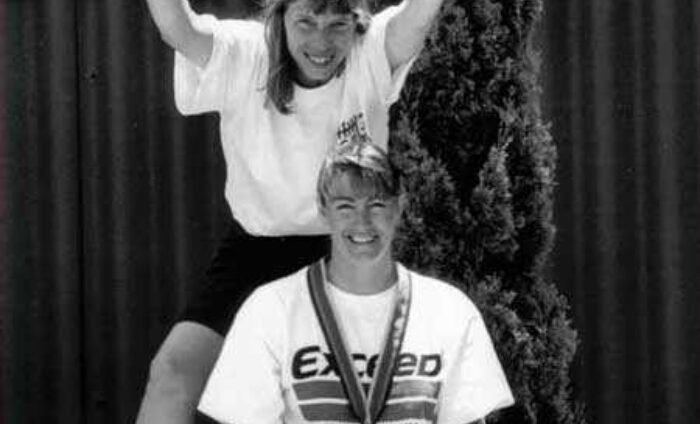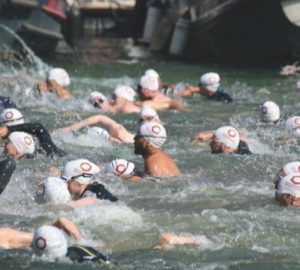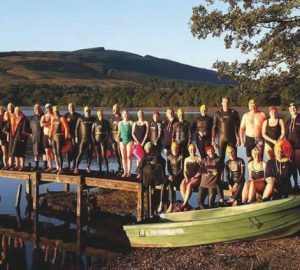
Shelley Taylor-Smith: dangerous when wet
SEVEN time World Marathon Swimming champion Shelley Taylor-Smith talks to H2Open about swimming, life and her joy in helping other people achieve their goal.
The nickname ‘Dangerous When Wet’ served both as Shelley Taylor-Smith’s nickname throughout her dominance of open water swimming in the 1990s and as the title of her 1996 biography.
But not only was she dangerous to her competitors, she was dangerous to herself. In 1992, while representing her beloved Australia, she pushed herself so hard – ignoring symptoms of hypothermia – that she had to be dragged unconscious from the water and woke up in hospital.
“My greatest sporting strength – my mental determination and ability to withstand discomfort and pain – turned out to be my greatest weakness. I didn’t know when to stop,” she says. Taylor-Smith admits she could have died that day if her coach and support team hadn’t been alert to the danger.
Such an experience could have been career limiting, but she recovered within two weeks to win again and to go on winning – beating both women and men – year after year. She accumulated numerous titles and records along the way, including seven consecutive years as the No.1 marathon swimming woman in the world. How did she do i
“Early in my career, my sports psychologist told me I had a ‘champion mindset’,” Shelley remembers. “It wasn’t my physical condition that allowed me to win races but what went on between my ears – the most important six inches of your body.
For example, when I won my first World Championship someone asked me, ‘At what point in the race did you know you would win?’ However, it wasn’t during the race, it was about four years before.” Her ‘champion mindset’ wasn’t just an unshakeable belief that she could perform on race day; it underpinned her entire approach to training and preparation.
“In my race preparation, I was always determined not to leave any stone unturned to make sure I could be the best I could possibly be on the day, that I was prepared for every eventuality,” she explains.
Open water swimming training: it’s between the ears
Her mental preparation even allowed her to deal easily with one eventuality that most swimmers dread – jellyfish. When Taylor- Smith qualified to represent Australia in the Inaugural Women’s 25km swim in Perth, Western Australia, at the FINA World Swimming Championships in 1991, she knew jellyfish would be on the agenda. She also knew most of her competitors would take the approach of hoping for the best and dealing with any stings on the day. She approached it differently.
“The jellyfish couldn’t be avoided so in my mind I made them my friends and supporters. If I head-butted into them, they were my supporters, cheering me on. The ones that stung were showing their affection. The stings were their kisses and I gave them a score out of ten for each kiss, depending on how much it hurt.” Guess who won the race? Of course, she did.
And, did you notice how casually we wrote ‘25km’? That should probably be highlighted in bold font with exclamation marks around it. That distance at all is no small acheivement, never mind in jellyfish-infested waters. For Taylor-Smith, that was 5 hours and 21 minutes of swimming, while it would take most of us more than 10.
How did she do it? Her top tip, she says, is to train yourself to create comfort out of discomfort. Instead of fearing cold water, for example, you have to make it your friend, embrace it and love the sensation on your skin. Similarly with pain. When she was suffering in a race, instead of easing back she would ask herself, “How much more can I make it hurt?” and push harder.
Another technique Taylor-Smith has used and recommends is disassociation. “In some way, I wasn’t in my body for many of my swims. I’d be partly there, monitoring what was going on, but I might also be on a desert island with Tom Cruise, or in the body of my coach watching me swim. I can remember the beginning and end of my swims, but not the middle.”
Open water swimming wasn’t Taylor-Smith’s first career choice. She started out as a pool swimmer, but her body let her down. Since childhood she has suffered from scoliosis, an abnormal curvature of the spine. While on a swimming scholarship at the University of Arkansas she suffered partial paralysis and lost her place in the team.
As she recovered, her coach, Sam Freas, called her up and reminded her of her potential to be a world marathon swimming champion – a future career without any tumble turns and dive starts that would jolt her bad back. She was soon hooked.
Swimming had always been a priority in the young Shelley’s life.
As a teenager, doctors advised inserting a steel rod into her spine but she knew that would cost her the flexibility she needed to swim, so she refused. Swimming was important as it helped her to feel normal, and she says it probably kept her out of a wheelchair.
“I never thought of myself as disabled. This is just the body I wasborn with so I had to make the most of it,” she says. “Swimmingset me free. The discomfort and awkwardness I felt on land disappeared and I could enjoy the waves, the fish swimming below me, the cold on my skin and sunsets and sunrises across the water.”
Marathon Swimming Series was changed forever
This positive approach to life and swimming has brought her a long list of titles, records and medals but she’s most proud of the fact that, by beating men and becoming the world No.1 for both men and women in the 1991 Professional Marathon Swimming series, she prompted the governing body to separate the men’s and women’s rankings and offer equal prize money for both sexes. She says she couldn’t have done it alone, and credits her parents for the part they played in her success.
“My father, who died when I was only 15, made me the mentally tough athlete I am. From my mother I learned to be a strong and assertive woman and to stand up for what is right and just.” Her mother passed away last year, on the same day as US open water swimmer Fran Crippen.
“To lose them both in one day was terrible. I was very close to Fran. He was an outstanding human being. It was amazing to watch him race because of the way he looked after his fellow competitors. I’d certainly list Fran as one of my heroes.”
The other hero she mentions is Australian multi-Olympic medallist Dawn Fraser. “Dawn helped me enormously at the beginning of my career. She took me under her wing, helped me deal with the media and sponsors, so that I could focus on swimming and winning. She was also instrumental in my move from Perth to Sydney.
On top of that she’s a fantastic person to be around. When she talks, people listen. She treats everyone with respect – as she’d like to be treated – whether they’re the prime minister or the janitor. She could also give me a good kick up my butt if she thought I needed it.”
Since retiring as a professional swimmer, Taylor-Smith, has set up a coaching business called Champion Mindset, through which she shares the mental skills that helped her become a great athlete: “I love to help people achieve their own Everests,” she says. “Not only swimmers but people from all walks of life.”
She believes people’s mental state and negative self-talk often prevents them achieving their goals, and sometimes they don’t realise they’re doing it. “You often hear people say things like, ‘I can’t cope with the cold,’ or, ‘I’m not good enough,’ and these types of statements become self-fulfilling. People worry too much about failure. They ask, ‘What will people think if I don’t make it?’ This kind of thinking saps a lot of energy. I teach that failure is just one step closer to getting what you want.”
Taylor-Smith says she uses a tough-love approach with her clients to overcome their greatest competitor – themselves. She wants them to face up to the thoughts and worries that are holding them back, teaching them success strategies that replace negative “stinking thinking”. The trick is to visualise these success strategies repeatedly to enable them to stick. “After all,” she says, “we are creatures of habit!”
Sometimes it can be simple things that ruin a race. “Even small things can drain incredible amounts of mental energy and people just don’t realise. For example, say you had a label in your swimsuit that you wanted to cut out before the race but you forget. You remember when you start swimming and suddenly, in your mind, it becomes a big problem. In the water all your senses are magnified. You feel the tag in your swim suit rubbing and chafing against your skin in the salt water and it hurts. You start cursing yourself for not cutting it out and you’re no longer in the race.”
Taylor-Smith suggests using a mental locked box to put away negative thoughts of costume labels, flapping toe nails, foggedup goggles and all our other worries. Lock them up and get on with your swim. Similarly, her motto for everyday life is: “Get up, get over it and get on with it.”
In addition to her Champion Mindset business, Taylor-Smith remains active in the world of swimming as advisor and official to FINA, the sport’s governing body, and in her native Australia. “I was Honorary Secretary of the FINA Technical Open Water Swimming Committee from 2000-2009 – the only woman in an all male environment. At first some thought I was the type of secretary that makes the tea. I soon put them straight,” she says, in peals of laughter.
Looking forward, Taylor-Smith hopes to do more of what she does at the moment. “I want to use my 30-plus years of experience to help teams and individuals in the sporting world from beginner level onwards, as well as business people on performance and lifestyle issues, to discover the mental toughness needed to stay on top of their game despite the daily obstacles they face.”
In other words, helping other people become ‘dangerous when wet’. Or dry, for that matter.






